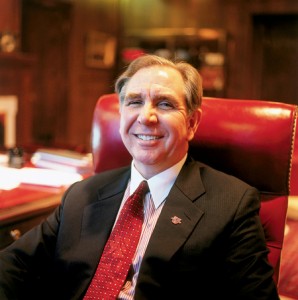
Michael K. Young’s past finally caught up with him.
Chosen as the University of Utah’s 14th president in April, Young has had to endure lighthearted ribbing from his new U colleagues about his BYU connections, which include bachelor’s degrees earned in Japanese and political science from BYU in 1973.
“The teasing has been very good natured and amusing,” says Young, laughing. “And, yes, the blueness of my wardrobe is monitored on a daily basis.”
Although the majority of his career has been spent outside Utah, Young fondly remembers the influence of a handful of BYU professors who helped him on his way to a successful career filled with legal and international experience.
“As I reflect on my time at BYU and where I am now, what vividly sticks out in my mind were those occasions—and there were several of them—in which professors singled me out and thrust themselves upon me as mentors,” says Young, who left his six-year post as dean of the George Washington Law School to take the helm at the U. At the time, he says, he was content to inconspicuously attend his classes, but certain professors drew him in to their circles of influence. “These mentors changed my sense of myself. They changed my sense of my own capacity. They fundamentally and profoundly changed my professional horizons.”
Those horizons have included a law degree from Harvard University, time spent clerking for U.S. Supreme Court justice William H. Rehnquist, and work for the U.S. State Department. For 13 years prior to his time at George Washington, Young was the Fuyo -Professor of Japanese Law at Columbia University. He is currently serving his second term as chair of the U.S. Commission on International Religious Freedom, which was created by Congress to monitor U.S. government efforts to promote religious freedom internationally.
Young, a 54-year-old Chester, Calif., native, attended public schools in Provo and then graduated from the old B.Y. High before attending BYU. His extracurricular activities at BYU, he says, involved a lot of time on the ski slopes. It was time well spent—during his first semester at BYU, he caught a glimpse of Suzan Stewart, ’78, at Sundance, where they were both ski instructors. Persuading Stewart to marry him “was clearly the most successful thing I accomplished at BYU,” says Young, who has been married nearly 32 years and has three children attending colleges across the country.
As an undergrad in Provo, the idea of becoming a university president, let alone president of the U, never occurred to him. “It actually never crossed my mind that I would even be a teacher. I went into BYU completely committed to being a lawyer; I left BYU completely committed to being a lawyer,” he says. “It never occurred to me I would be an academic, much less a dean, much less a president. It’s been a series of happy, random events.”
Typically regarded as a bridge builder and diplomat, Young applauds collaboration between his alma mater and the U. “We have fun with the rivalry,” he says, “but in fact, BYU is a partner in so many ways.” He believes that the state of Utah is in a position where advances in its economy will come in the form of ideas, technologies, and products created by its universities.
“Tourism, natural resource extraction—those are very, very limited economic possibilities for the state. But there are great universities here that can produce the kind of research and technology that can then be translated into great business opportunities and products that make people’s lives better,” says Young. “To do that you have to have a couple of things—one, a high level of sophisticated research, and two, a sophisticated workforce that has the scientific and technical understanding to power the knowledge economy. BYU and the U complement each other in these areas.”
That the president of BYU is a former Ute and the president of the U is a former Cougar is an amusing thing, says Young, but it’s also a tribute to the state that the rivalry gives way to more important things. “It’s an interesting sign of maturity that people aren’t looking at the tags on the individuals as much as they are the individuals themselves.”
The Presidential Swap
Much fuss has been made about the transposed backgrounds of the current presidents of BYU and the University of Utah. But these are not the first heads of the two schools to claim the rival as an alma mater.
BYU Grads Leading the U
James E. Talmage, president 1894–97, 1879 Brigham Young Academy graduate
Ray Olpin, president 1946–64, 1923 BYU graduate
David P. Gardner, president 1973–83, 1955 BYU graduate
Michael K. Young, president 2004–present, 1973 BYU graduate
U of U Grads in BYU’s Presidential Chair
Merrill J. Bateman, president 1996–2003, 1960 Utah graduate
Cecil O. Samuelson, president 2003–present, 1966 Utah graduate
In addition to the graduates listed here, James C. Fletcher, president of the U from 1964 to 1971, attended BYU but graduated from Columbia University. And George H. Brimhall, BYU president from 1904 to 1921, studied at the Timpanogos Branch of the University of Deseret (later renamed the University of Utah). Interestingly, the Timpanogos Branch was a Provo extension of the university; after financial problems forced its closure, it reopened the next year with the same principal in the same building but with a new name: Brigham Young Academy.






